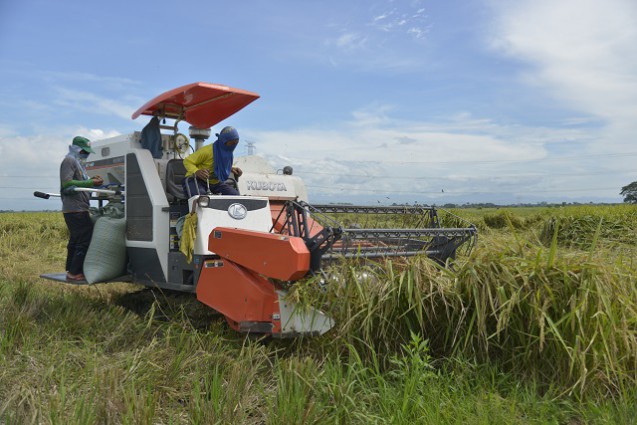
Using combine harvester is one of the ways that can help farmers reduce production cost and save more from their income.
The Department of Agriculture through the Philippine Rice Research Institute (PhilRice) has technologies in place to help lessen the impact of TRAIN law to the rice farmers.
Dr. Sailila E. Abdula, PhilRice executive director, said yield-enhancing technologies such as machines, water management, and varieties are easily available for the rice growers to offset the P0.50 increase in the production cost of pump-dependent farmers. TRAIN or Tax Reform for Acceleration and Inclusion Law became notorious to the farmers with its provision on higher specific tax on petroleum products, which was last increased in 1997.
PhilRice data show that a typical farmer uses 397 l/ha of fuel from land preparation until harvesting while the more mechanized farmer consumes 413 l/ha. The difference, 16-26 l/ha, adds P600-1,000/ha more cost. However, Abdula said it can be offset by using combine harvester alone.
“By using combine harvester, farmer gets an additional net income of P6,000, which came from the savings he obtained from reduced labor cost in harvesting, threshing, and using sacks and twine,” Adbula said.
The executive director also said farmers earn P3,527 more from the 4-in-1 machine, as it reduces postharvest losses from manual harvesting, axial-flow threshing, and piling.
To further save on fuel, PhilRice promotes rice hull, a common farm waste in rural communities, in powering up water pump. Rice hull gasifier pump system, a water pump gasifier that burns rice hull as fuel, is available for farmers; giving them a savings of 30-40% on irrigation cost per season.
Alternate wetting and drying technology, or irrigating the field few days after water level has dropped to about 15 cm below the surface of the soil, is also an easy farm practice that gives a 16-35%-savings without decreasing yield.
Meanwhile, farmer Rolando San Gabriel of Maligaya, Science City of Muñoz, Nueva Ecija said his fellow crop growers can cope with the TRAIN law by planting rice varieties that yield more harvest.
“We cannot control the prices, but we are in control of our farming practices. We must have a target yield per cropping season and see how we can cut down on the cost. We can start with our choice of rice varieties,” he said.
Gabriel said he planted NSIC Rc402, which has a maximum yield of 14 t/ha and matures in 114 days. High-yielding varieties that can produce an additional yield of 105 k/ha are available in PhilRice stations and seed centers.
San Gabriel said he will reduce his operational costs come planting season through dry plowing during land preparation and implementing just two of the usual three harrowing. He said he will also reduce his nitrogen application.
“I will still farm despite cost adjustments. With right strategies, farmers can survive the TRAIN law,” he said.




